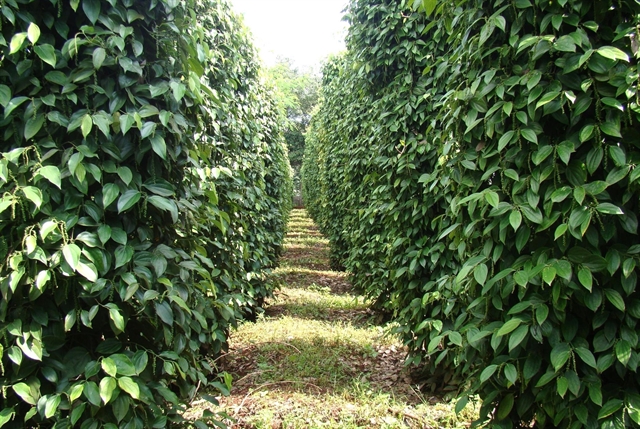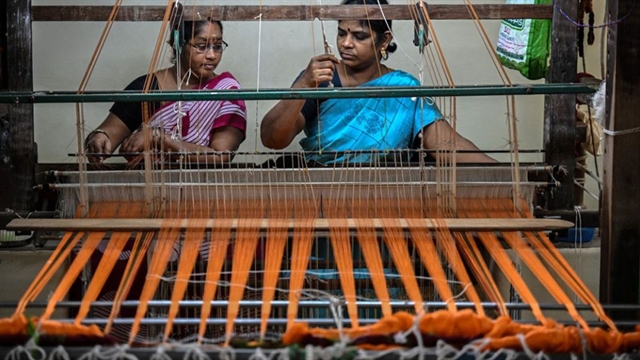.jpg) Society
Society

 |
| A pepper farm in Gia Lai Province grows and develops sustainably thanks to natural-farming practices. — VNA/VNS Photo Hồng Điệp |
GIA LAI — More pepper farmers in Gia Lai Province are turning to natural farming methods, helping to recover pepper cultivation damaged by diseases.
By using organic fertilisers, home-made probiotics and herbal pest solutions, farmers are restoring their crops after years of damage caused by “quick wilt” and “slow wilt” diseases.
These methods help maintain soil fertility, improve plant resistance, stabilise yields and adapt better to climate change, according to the provincial Department of Agriculture and Environment.
Nguyễn Tấn Lục, who has grown pepper for more than 20 years in Chư Sê Commune, has focused on improving soil with organic fertiliser and regularly uses Trichoderma and home-fermented probiotics to increase beneficial microorganisms.
“Since 2016, I have only used Trichoderma and self-fermented probiotics. I apply them about 10 times a year in both dry and rainy seasons. Thanks to that, my pepper garden stays healthy, with almost no ‘quick wilt’ or ‘slow wilt’ disease.”
This approach has helped nearly 1ha of his pepper maintain stable yields, he said.
Many farmers also make a herbal solution to treat sap-sucking pests that cause yellowing, curling and leaf drop.
In Ia Pia Commune, Võ Thị Tuyết makes her own herbal solution from garlic, ginger, chilli and lemongrass soaked in alcohol to control pests, which reduces chemical costs.
“This method is cheap and effective, and I do not need chemical pesticides. My pepper garden is green again," she said.
In Bờ Ngoong Commune, many farmers intercrop pepper with coffee using organic methods, retaining natural ground cover and adding decomposed manure.
Rơ Mah H’Hoang, who intercrops pepper with coffee in Bờ Ngoong, said the intercropping model helps retain soil moisture and reduce pests.
“I use bio-fertiliser and ferment agricultural waste, so my pepper grows well and has fewer diseases. Last year, I sold pepper for VNĐ120,000 (US$4.6) per kilogramme. I hope prices remain stable so farmers can feel secure in the long term.”
Thanks to natural farming, her pepper vines produce 4-5 kilogrammes per post.
Located in the south-central Coastal-Central Highlands region, Gia Lai has more than 7,500ha of pepper. Of this amount, 6,157ha are under harvest, with an average yield of 3.5 tonnes per hectare and an output of about 21,670 tonnes a year.
More than 2,680ha use water-saving irrigation and 383ha are certified under Vietnamese good agricultural practices (VietGAP), organic or rainforest standards.
Chư Sê Commune is one of the province’s largest pepper growing areas.
Hoàng Phước Bính, permanent deputy chairman of the Chư Sê Commune Pepper Association, said healthy soil is crucial for pepper.
The Tây Nguyên region’s basalt soil has a pH of 4-5, which favours plant pathogens, he said, adding that when the pH is raised to 5.5-6 through organic fertiliser and periodic soil improvement, pepper grows better, disease risks fall and production efficiency rises.
Nguyễn Quang Ngọc, director of the Pepper Research and Development Centre at the Western Highlands Agriculture and Forestry Science Institute, said natural farming is essential for pepper to adapt to climate change.
Up to 95 per cent of pepper in Tây Nguyên is the Vĩnh Linh variety, which is easily damaged during disease outbreaks, he said.
The centre is researching and selecting new varieties with better resistance to reduce the risk of relying on a single variety, he said.
Each farmer needs to become an “expert” in their own garden, detecting pests and diseases early, and using plant-protection chemicals correctly to ensure environmental safety and product quality, he said.
Pepper in the province once went through a period of rapid expansion. At its peak period, the pepper area exceeded 18,000ha, and prices rose to VNĐ200,000-250,000 ($7.6-9.5) per kilogramme, helping many households escape poverty.
However, fast expansion, overuse of chemicals and excessive irrigation degraded the soil, weakened plants and triggered widespread disease. This forced many farmers to scale down production or switch to other crops when prices fell.
Farmers now focus on quality, safety and traceability for pepper cultivation.
Models that retain natural ground cover, include proper drainage, increase decomposed manure and limit inorganic fertiliser are widely adopted.
These practices reduce investment costs, stabilise yields and improve product quality, meeting export-market standards.
With support from agricultural agencies and a shift in the production mindset of farmers, the province’s pepper cultivation is steadily recovering. — VNS




